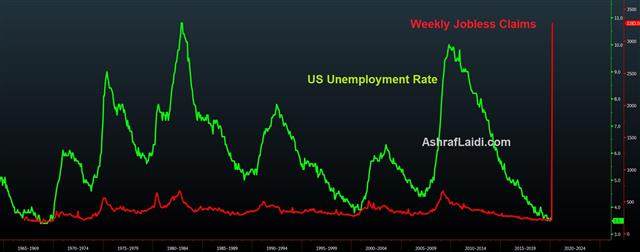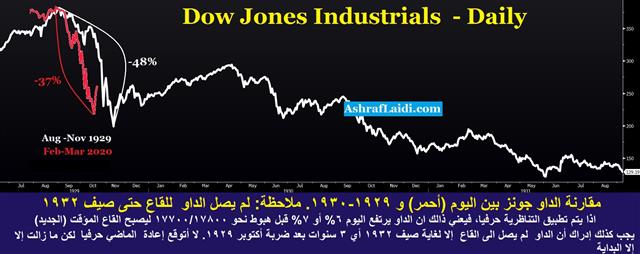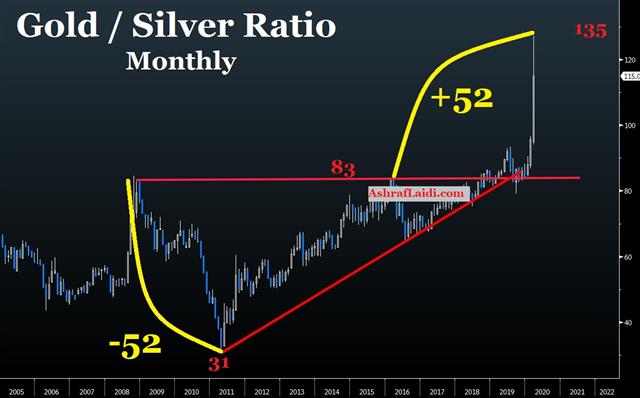Intraday Market Thoughts Archives
Displaying results for week of Mar 22, 2020Month End, Beginning of the End?
Markets brushed off a massive number of US unemployment claims in a sign that much of the bad news is priced in; or maybe it's a sign of month and quarter-end flows. Sterling was the top performer while the US dollar lagged. Weekend risk looms. Wednesday's Premium trade is +280 pips in the green. A new trade in the Premium Insights went into after the NY Thursday close.

US initial jobless claims soared to a record 3.283 million compared to 281K the week before and sashing the 1982 record of 695K. It was a harrowing number but risk trades climbed on the headlines. We warned yesterday that even a number in the 2-3m range might be seen as good news because there were whispers and worries of worse. Evidently a number even slightly higher than that was enough to satisfy bargain hunters in the market.
In terms of the coronavirus, the US is now the epicenter of the outbreak with the total number of cases surpassing China; or at least the official numbers. That also didn't derail the risk trade and the DJIA gained 6.4% in its largest 3-day rally since 1933.
Part of the moves are clearly a sign of relief that the government and central banks have averted a cascading financial crisis. Markets were on the brink of a freeze-up and meltdown earlier in the month and it took unprecedented pledges to buy nearly everything to save them; but it appears to have worked.
That's some reason for celebration. We also highlighted month and quarter-end rebalancing earlier in the week. Given the drop in stocks and rally in bonds, balanced funds need to adjust their allocations of each and that means stock buying and bond selling. Estimates were for $240B in flows but talk of it was widespread and at some point the story itself attracts far more buyers in a massive front run.
There are currently 6 existing trades open in the Premium Insights, 2 in FX, 1 in commodities, 1 in indices and 1 in cyrpto. Each of the 6 trades is currently in the green.
Another clear sign that liquidity conditions have improved is the fall in the dollar. It sank across the board Thursday and the beaten-down pound was particularly perky in a climb to 1.2175.
The calendar is the main obstacle in the day ahead. We've seen epic selloffs and squeezes into recent weekends. Markets shouldn't be under any illusions that cases will continue to climb over the weekend but we remain in a highly volatile situation and the mood can change quickly.
Cable Chaotic, Claims Coming, 1929 Analog
Sterling went on a wild ride Wednesday in another sign of domestic worries and a market that isn't functioning properly. The Canadian dollar led the way while the US dollar lagged. All eyes turn to US weekly jobless claims due Thursday, which should be one for the ages. A new FX trade for the Premium Insights with 3 charts & notes has just been issued.

The pound continues to confound. Cable took a run at 1.2000 early in London trade but fell just short and from there it was slammed down to 1.1640 over 5 hours. In another twist in then grinded back to 1.1900 after London went home. There's no explaining the intricacies of that move. Some of the late day strength was on general USD weakness but the overall move was chaotic and a sign of a skittish market at best, and a malfunctioning market at worst.
Ashraf says to bear in mind EURGBP dynamics for understanding GBPUSD, especially the reccurring 0.93 resistance, acting to support GBPUSD.
The UK Treasury said it will unveil new measures for self-employed people Wednesday and local virus experts were upbeat about the ability of hospitals to cope with the virus but more pictures of packed trains don't bode well.
The broader theme in the market was also confusion. Overall moves were smaller in all markets with a modest risk-on tone but all the moves lacked conviction.
In another quirk, the US dollar, Aussie and yen were entirely unchanged against one another. The Canadian dollar, meanwhile, gained 2% against all three in part because of a +$100B stimulus package from Canada and a climb in oil.
Another thing we have to consider for CAD is yield. The Bank of Canada remains at +0.75% while all other major central banks are at least 50 bps lower. US bill rates out to three months went negative Wednesday while Canadian June paper pays 0.62%. At least for domestic safety-seeking investors, that might be some incentive to bring money home.
Looking ahead, all eyes will be on the US weekly jobless claims number on Thursday. The consensus is 1.5 million claims compared to 280,000 last week. The all-time record of 695K will almost certainly be broken and economist estimates range up to 4 million. Even a number in the 2-3 million range might be seen as 'good' news because some states are showing 20-40x more claims than normal. If there's a miss on the downside, it may simply because some states aren't able to process the benefits – there are widespread reports of outages.
Given all the quirks, it will be easy enough to explain away any number but either way the data will be a test of market sentiment. From there, traders will begin to position for weekend risks.
Stocks Record Bounce, JPY Plunges, NY Cases Soar
The Dow Jones Industrial Average climbed jumped 11% -- the most since 1933 to prove the adage that bear-market rallies are the most-powerful. The Australian dollar was the top performer while the yen lagged. USD/JPY continues to close in on the Feb high. Gold extends its gains on a powerful combination of miners shutdown and Fed's historic QE trigger. Ashraf posted a special Premium video below (English and Arabic in one), focusing on key trading dynamics between gold, silver and S&P500.
Global equity markets snapped back in their largest one-day rallies in years. Most of the one-day gains date back to 2008 or 2011 but the DJIA climbed 11.4% in the biggest single-day gain in since the Great Depression.
That last tidbit is instructive as there are only a handful of years that have ever had +8% rallies: 1929, 1931, 1932, 1933, 1987 and 2008. None of them marked the bottom. Moreover, the biggest-gaining stocks in the S&P 500 were airlines, casinos and cruise lines; suggesting this was a short-covering rally. In any case, the market still didn't breach Friday's high.
That doesn't mean it will only be a one-day event. Quarter and month-end rebalancing is expected to add +240B in equity flows this month and the equivalent among of bond selling. Given the extreme volumes trading right now, that's not a high amount but climbing yields Tuesday indicate it might be a factor.
On the fundamental side, the Markit services PMIs were generally poor. US and German manufacturing numbers were surprisingly strong but that won't last.
The more important numbers are on the virus. Italian cases are showing some signs of stability but the epicenter is moving to New York state where cases rose to 25.6K from 20.9K a day earlier. One-in-three tests are resulting in a positive and that's higher than anywhere testing en masse. Given the trajectory, New York is likely to surpass Wuhan's case number in a week. Governor Cuomo said the best-case scenario was a peak in 14-21 days.
Numbers elsewhere are also beginning to jump.
In FX, USD/JPY edged to a one-month high of 111.71 but is losing momentum ahead of the Feb high of 112.23.
USD/JPY has been a tough trade for the past five-weeks, defying the usual correlations and confounding traders. At some point the demand for USD liquidity will fade and the market will trade on the economic impacts but the timing is a difficult call. Whether the Feb high holds or sparks a further squeeze and USD super-spike will be telling.
Will Fed Going Nuclear Hurt USD?
Finally, the Federal Reserve went way beyond anything it had done previously in terms of asset purchases and yields across the US curve are nearing zero. The kneejerk reaction was to sell the US dollar but that move faded and that may continue. Congress still failing to reach a deal, forcing stocks lower until the last half hour of cash and late futures trading.The UK announced a full lockdown with cable near 35-year lows. A new non-FX non-Indices Premium trade was issued today.

13 is the number of Fed stimulus programs and actions, created so far this month--with Monday's awe-inspiring move. It included unlimited QE in government-backed debt at $125B per week, corporate bond buys, a TALF that includes credit card debt and a promise to create a 'main street lending program'.
The shock from the program initially weighed on the US dollar, but over time the effect faded. A risk in evaluating this crisis is looking at it from a US or European perspective. It's truly a global event. The moves will ease funding stress, but by underwriting credit risk, the Fed also makes USD-assets more attractive. Contrast that with emerging and developed market central banks that don't have the same capability.
Even if the moves eventually help to draw a line under US equities, that will simply pull in more foreign capital and drive up the US dollar. Could the US dollar continue to hold firm despite further gold gains in the horizon?
In the UK, Boris Johnson announced a three-week complete lockdown of the country. It marks a turnaround in policy from a week ago and will mean a severe short-term hit to the economy but that may prove to be less than a crippling outbreak. Cable remains severely oversold but is trying to carve out a bottom at 1.1400. Watch that level.
Looking forward, the day ahead will feature a continued close watch on US Congress and attempts to pass a stimulus bill. The latest price tag is an astonishing $2.5 trillion, which will likely push the budget deficit above $4 trillion this year. In terms of getting it done, it's always questionable to bet money on Congress and Senate Republicans after they lost a significant amount of leverage, with 5 members in quarantine.
In terms of data, the March prelim Markit manufacturing and services numbers are out for a number of countries. Those should provide an early look at how hard shutdowns are hitting but be careful to draw any conclusions because most of the surveys will have been conducted before the full shutdowns.









